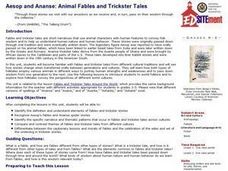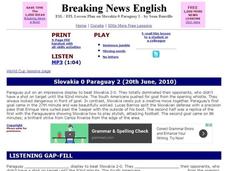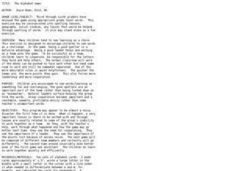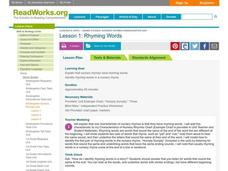Curated OER
Constructing Contractions
Young writers participate in a game to practice making contractions and using the apostrophe properly.
Ohio Department of Education
Word Origins
Understanding a word's etymology can really help with decoding and building vocabulary skills. Readers compare and contrast words of similar origins but with different difficulty levels. They focus on prefixes, suffixes, and affixes....
Curated OER
To Quote or Not to Quote
Quotation marks are the focus of this resource. In it, youngsters discover how to correctly use punctuation marks. It is meant to be carried out over a three-day period. You could shorten it, but I wouldn't. The activities are...
Curated OER
Write Right!
After watching part of a Club Write Kids video and discussing the editing process, each group of learners writes a letter to a favorite author. They ask for a copy of a page of manuscript that has gone through the editing process. Prior...
Curated OER
Aesop and Ananse: Animal Fables and Trickster Tales
Students complete compare and contrast activities dealing with fables and trickster tales to determine how each uses animals to portray human characteristics, specifically strengths and weaknesses, as well as pass wisdom from one...
Curated OER
Cyberbullying and Civic Participation
Encourage your class to create rules and regulations for cyberbullying. Learners explore civic participation by thinking about the rules and regulations already in place in their lives and studying Canada's Canada Gazette. As a final...
WakeGOV
Plastic Sight Words
Plastic math? Have young learners count and name the number of plastic items in their centers. Kindergartners match sight word cards to the number of plastics in a given group, while learning that plastics come in all different shapes,...
Curated OER
Worksheet 2: Demonstratives
Sometimes it's difficult to identify the idea that demonstrative pronouns refer to. Polish the use of this, that, those, and these in your class's writing. Several sentences are given, and your pupil must rewrite the sentence to clarify...
Curated OER
Here's an Instant Activity: Onomatopeia Word-Search
Eighth graders complete a worksheet on onomatopoeia. In this spelling instructional activity, 8th graders review the concept of onomatopoeia. The attached worksheet for students includes a word-search of thirty onomatopeic words....
Curated OER
Double S, F, and Z
In this spelling activity worksheet, students add another consonant to complete the 12 words. Students rewrite the words in the next 12 examples. Students then read the sentences and look for the double s, f, and z letters. Students...
Curated OER
Street Art
Students read and summarize texts about street art. In this language arts lesson, students construct cleft sentences. They answer several grammar exercises and discuss the answers in class.
Curated OER
Hot Seat
One student is selected to come to the front of the class and take the "hot seat" facing his or her classmates and with his or her back to the board or chart. The student should have a clear view of the class word wall. Classmates select...
Curated OER
Breaking News English: Argentina 3 Mexico 1
In this ESL activity, students read or listen to an article about the Argentina and Mexico World Cup soccer game. Students complete all or some of the 100 activities available here including discussion, listening, vocabulary and...
Curated OER
Breaking News English: Slovakia and Paraguay
In this Slovakia and Paraguay worksheet, students read the article, complete a gap fill, answer short answer questions, complete a survey, write, and more about Slovakia and Paraguay. Students complete 10 activities total.
Curated OER
The Great Kapok Tree by Lynne Cherry
With The Great Kapok Tree, by Lynne Cherry as the hook learners discuss the rainforest, the animals that live there, and conservation efforts. Then, students write a letter to the man in the story asking him not to cut down the Kapok...
Curated OER
Shakespeare Wall
Students create a visual notebook of a Shakespearean play by taking the actual written work, hanging it up on the wall, and highlighting various literary aspects of the play as they unfold.
Curated OER
Vocabulary Toss
Students play a vocabulary game. When they identify the correct work-wall word, they earn a point and a chance to double his or her point by shooting a basket. This game is designed to reinforce vocabulary skills by providing a fun way...
Curated OER
Truly Amazing Mammals
Explore the world of amazing mammals with your kids with special needs. Each child identifies one mammal from a previous lesson and writes a short paragraph on that mammal. This lesson states that it is intended for all levels, but not...
Curated OER
The Alphabet Game
Students spell words using cards with each letter of the alphabet on them. In this alphabet lesson plan, students word in 2 teams and get points for the first team to spell the word correctly.
Curated OER
"EA" Beach
Students are introduced to their new spelling words for the week which have the sound "ea". In groups, they brainstorm a list of other words with the same sound, draw them and write them on a worksheet. They share their new words with...
Curated OER
Parts of Speech: Active Verbs
Students use White Fang to help them study active verbs. For this grammar lesson, students define active verbs and find examples in the the novel White Fang. Students then use ProQuest to research a place they'd like to visit. Students...
Curated OER
Learning About Evaluation
Learners determine how to evaluate non-fiction student writing. In this evaluation lesson, students write two non-fiction writing pieces for homework. They exchange writing pieces with a classmate and evaluate the writing for proper...
Curated OER
Rhyming Words
Examine the rhyming words in nursery rhymes. Kids identify rhyming words by looking at the end spelling, and underline the parts of the words that are the same. They then complete guided practice and independent practice.
Curated OER
When (Seasons, Day, or Night)
Practice identifying the setting with a reading activity. Kindergartners find the setting of a story by observing when the story takes place. They read the book Look! Snow! by Kathryn O. Galbraith and decide in which season the story...

























